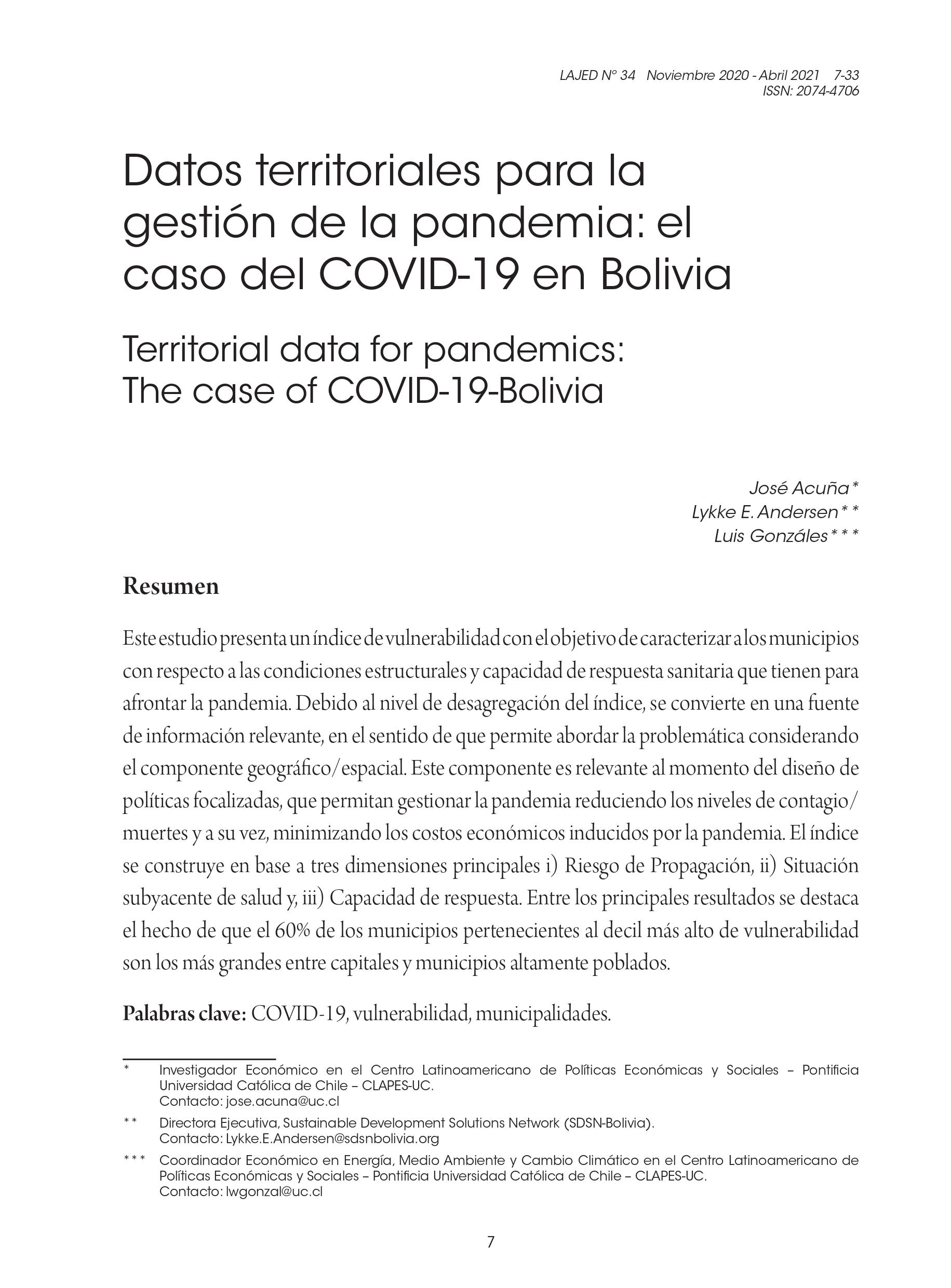Territorial data for pandemics: The case of COVID-19-Bolivia
DOI:
https://doi.org/10.35319/lajed.202034424Keywords:
COVID-19, Vulnerability, MunicipalitiesAbstract
We estimate a COVID vulnerability index in order to characterize all Bolivian municipalities with regard to their structural conditions and their sanitary capacity facing the pandemic. The municipal disaggregation of the index becomes a relevant source of information when prioritizing the demands of the epidemic. For example, it can help guide the distribution of tests, protective equipment and vaccines so as to reduce the levels of contagion and deaths while also minimizing the economic costs incurred. The index is constructed based on three main dimensions: i) Risk of propagation, ii) Underlying health situation, and iii) Response capacity. Among the main results, stands out the fact that 60% of the municipalities belonging to the highest decile of vulnerability are the most populous municipalities.
Downloads
References
Acuña, C.; Cerda, R.; González, H. y Larraín, F. (2020). Covid-19: un modelo para determinar la probabilidad e intensidad de una segunda ola de contagios. Documento de Trabajo de CLAPES UC Nº 82.
Acemoglu, D.; Chernozhukov V. et al. (2020). Targeted Lockdowns in a Multi-Group SIR Model. National Bureau of Economic Research. Working Paper Nº 27102.
Anda-Jáuregui de, G. y Hernández-Lemus, E. (2020). Modular Reactivation of Mexico City After COVID-19 Lockdown. arXiv preprint arXiv:2008.12688
Andersen, L. (2020). Forty Days of Quarantine-What Have We Learned? Sustainable Development Networks Solution-SDSN Bolivia. Disponible en: https://www.sdsnbolivia.org/en/english-forty-days-of-quarantine-what-have-we-learned/
Andersen, L. E.; Canelas, S.; Gonzáles, A. y Peñaranda, L. (2020). Atlas municipal de los Objetivos de Desarrollo Sostenible en Bolivia 2020. La Paz: Universidad Privada Boliviana, SDSN Bolivia.
Argente, D.; Hsieh, C. y Munseon, L. (2020). The cost of privacy: Welfare Effect of the Disclosure of Covid-19 Cases. National Bureau of Economic Research. Working Paper Nº 27220.
Baqaee, D.; Farhi, E.; Mina, M. y Stock, J. (2020). Reopening Scenarios. National Bureau of Economic Research. Working Paper Nº 27244.
Birge, J.R.; Candogan, O. y Feng, Y. (2020). Controlling Epidemic Spread: Reducing Economic Losses with Targeted Closures. Becker Friedman Institute Working Paper Nº 2020-57, University of Chicago, May. Disponible en: https://bfi.uchicago.edu/working-paper/controlling-epidemic-spread-reducing-economic-losses-with-targeted-closures/
Cardona C.; Cuba-Borda, P. y Gonzáles-Carrasco, L.E. (2020). Monitoreo en tiempo real del COVID-19 en Bolivia. Documento de Trabajo de CLAPES UC Nº 81.
Chivers, T. (2020). When will we get the Covid-19 vaccine? UnHerd. Disponible en: https://unherd.com/2020/04/when-we-get-the-covid-19-vaccine/?tl_inbound=1&tl_groups%5b0%5d=18743&tl_period_type=3
Greenstone, M. y Nigam, V. (2020). Does Social Distancing Matter? University of Chicago, Becker Friedman Institute for Economics Working Paper Nº 2020-26.
Jordá, O.; Singh, S. R. y Taylor, A. M. (2020). Longer-run economic consequences of pandemics. National Bureau of Economic Research. Working Paper Nº 26934.
Ricciulli-Marín, D. et al. (2020). Diferencias regionales en el impacto económico del aislamiento preventivo por el COVID-19: estudio de caso para Colombia. Documentos de trabajo sobre economía regional y urbana, Nº 290, Banco de la República.






